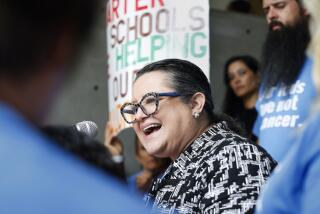24 San Fernando Valley schools seek charter status
Two dozen high-performing Los Angeles schools are seeking to become charter campuses in search of more money and increased flexibility.
The list reads like an honor roll of academic excellence. Every school has surpassed the state’s target score of 800 on the Academic Performance Index, which is based on standardized tests.
Although many of the schools considered the move in hopes of greater funding, campus officials said they also began to see the benefits of increased freedom over such things as curriculum, testing and schedules.
“Finance is one key factor but not the only one,” said Jose Cole-Gutierrez, who directs the charter school division of the L.A. Unified School District.
The Board of Education heard from several supporters of the schools’ plans Tuesday; it’s expected to vote on the proposals in June.
Charter schools are free from some restrictions that govern traditional schools. Independent charters sever most ties with the school system; L.A. Unified provides periodic oversight.
The 24 San Fernando Valley schools don’t want to go that far. They are seeking to become “affiliated” or “dependent” charters. Affiliated charters are still bound by the district’s union contracts, for example.
Becoming a charter of any sort results in a key advantage: The schools get a block grant from the state — about $385 per student — that can deliver more dollars with fewer rules.
“It’s quite positive” for the schools, said L.A. Unified Supt. John Deasy, adding that the increased money comes from the state, not from district resources, during a period of sweeping budget cuts.
L.A. Unified has more charter schools, 198, than any school system in the nation. Most are start-ups run by outside groups. So far, 13 existing campuses have become fully independent; 18 others converted to semi-independent status — seven of them last year.
“Along with the funding that would come along with it, we hope to try some new programs and innovations,” Principal Debra Hirsch of Dearborn Elementary in Northridge said in an interview.
The school plans to work toward “going green,” she said, increasing recycling efforts and adding gardening and nutrition education. The funding also would go toward maintaining help for lower-performing students and enriching instruction for gifted ones.
The Dearborn staff also would skip some district-required standardized tests in favor of exams designed to match a new reading program.
Enadia Way Elementary in West Hills hopes to use its discretion to purchase technology and train teachers to use it, said Principal Vivian Cordoba. She said her small school of 222 students needs to compete with other area campuses that have become charters. Also, charter status might blunt the possibility that the district would close her campus to save money, she said.
Some of these schools are about to lose funds formerly used to improve the academic performance of students from low-income families. The school system, however, has changed the way that money is distributed and is instead giving it to schools that serve a higher percentage of low-income students. This shift puts L.A. Unified more in step with federal guidelines on how such Title 1 money is to be used.
At Superior Street Elementary in Chatsworth, 43% of students are low-income. The previous threshold made a school eligible for aid when it reached 40% of enrollment. The new threshold is 50%.
For Principal Jerilyn Schubert, a change to charter status is largely about money to maintain programs.
“It’s an amazing opportunity because you’re 95% still part of L.A. Unified,” she said.
The school has used supplemental funding to pay for an instructional coach, intervention teachers, teacher aides, a library aide and a clerical worker — who does double duty as a nurse because such services are available just one day a week.
Superior’s academic achievement levels have surged in recent years to a top-tier score of 912 on the Academic Performance Index.
“We could not have made these gains without the support of this funding,” Schubert said.
L.A. Unified invited the schools to seek charter status if it would help them financially.
This year, Superior had about $120,000 in federal anti-poverty aid, which it will lose, and $80,000 in extra funds from other sources, Schubert said. As a charter, the school will lose its extra funds but receive more than $200,000 from the block grant.
The other Valley schools seeking charter status include two middle schools, Nobel and Millikan; Hesby Oaks, which is K-8; and 18 elementary schools: Balboa Magnet, Castlebay Lane, Dixie Canyon, El Oro Way, Encino, Germain, Hamlin, Haynes, Justice Street, Knollwood, Lockhurst Drive, Nestle Avenue, Serrania Avenue, Topeka, Van Gogh, Wilbur, Woodlake and Woodland Hills.
More to Read
Start your day right
Sign up for Essential California for news, features and recommendations from the L.A. Times and beyond in your inbox six days a week.
You may occasionally receive promotional content from the Los Angeles Times.







